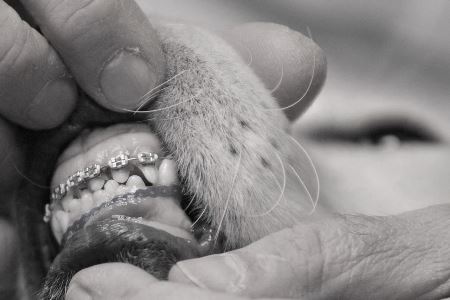You’ve probably wondered, “Can dogs get braces?” if your dog has crooked teeth or bite alignment issues. Perhaps you’re interested in learning more about dog braces for teeth after hearing about Wesley, a golden retriever puppy who had braces to correct their bite, according to Patch. Dog braces do exist, and have been used in veterinary dentistry and orthodontia for well over 30 years to help dogs with painful or life-threatening dental problems. While humans typically wear braces to improve their appearance, the goal of doggie orthodontia is to help a dog chew and eat normally. So, in this post, we’ll look at how much dog braces for teeth cost.
What are Dog Braces for Teeth?
Dog braces for teeth are orthodontic tools that are used to fix problems with the teeth, like underbites and malocclusions. Dog braces for teeth or retainers look like braces for people, but they work a little bit differently. People wear braces to make their teeth look better and to move them into a better position. Dogs, on the other hand, wear braces for medical reasons.
Dog tooth braces are used to correct chewing in dogs or to relieve painful adult tooth issues. For more than 30 years, dog braces have been used in veterinary dentistry.
Why Do Dogs Need Braces for Their Teeth?
There are several reasons why a dog might require braces. Some of these reasons are unique to certain dog breeds because of how their teeth naturally line up, while others can happen to any dog.
The following are the most common reasons for using dog teeth braces:
#1. Crowded Teeth.
This condition is most common in dogs who have extra teeth (retained deciduous or baby teeth) or rotated teeth, which cause crowding inside the mouth. Crooked teeth can cause damage to soft tissues, excessive wear, misaligned teeth, and a lot of pain. Tooth crowding can eventually lead to periodontal disease.
#2. Lance Teeth.
This is a problem unique to the breed. For example, Shetland Sheepdogs often have “lance teeth,” which are upper canine teeth that are more forward than usual. This could be in one or both of the front canines. This movement of the front tooth makes it touch the front incisors in a way that is not natural. This condition can make it hard to close your mouth, cause ulcers when your teeth touch too much and make you more likely to get gum disease.
#3. Overbites/Underbites.
These are genetic conditions that are prevalent in certain breeds. In such cases, the dog’s lower jaw is more prominent or far behind the upper jaw. This results in an irregular bite, also known as malocclusion. Dog braces for teeth can help align the lower jaw with the upper jaw and ensure a proper and comfortable bite.
#4. Linguoversion.
This is a breed-specific condition that is common in collie breeds. Linguoversion is the development of the lower canines inward rather than outward. This makes it difficult to close the mouth. Also, the upper roof of the mouth can get holes from the lower teeth rubbing against it all the time.
#5. Postoperative Treatments.
Teeth braces are commonly used as aftercare in cancer cases where the dog’s jaw is removed. The dog braces for teeth to keep the teeth in place.
What Are the Advantages of Dog Braces?
Dog braces for teeth can help with a variety of dental problems. Here are some of the advantages of using braces to treat your dog’s dental issues:
Alternative to Surgery.
The majority of the dental conditions listed above can be treated with surgery or tooth extraction. Linguoversion and crowded dog teeth are the most commonly recommended surgical treatments. However, not every dog’s age or health issues allow them to have surgery. Furthermore, surgeries are costly and necessitate significant investment in preoperative diagnosis and postoperative care. Dog braces are a non-invasive and safe alternative to surgery.
#1. Non-Invasive Treatment.
Braces can be difficult for your dog at first. However, after a few days of wearing braces, they become a part of their body and cause little discomfort. Teeth braces are a less invasive option for orthodontic treatment than surgeries, which are more painful and require a longer recovery period.
#2. Controlled Pressure.
Teeth braces function through controlled pressure. Braces are tightened in the misaligned area, exerting a controlled amount of pressure to gradually facilitate alignment without causing severe pain. Because it is a gradual process, the associated pain quotient is lower than with surgeries or tooth extraction.
#3. Easy Maintenance.
Dog braces for teeth are simple to keep clean daily. If necessary, they should be cleaned and sanitized. Although tartar deposits on braces are possible, they can be easily cleaned with a brush and oral antiseptics for dogs. As a result, braces are a painless and simple method of treating dental problems in dogs.
How Do I Know If My Dog Requires Braces?
If your dog is dropping food, is acting head-shy, has an overbite, or you notice any changes to its teeth, it’s time to see your veterinarian. Your veterinarian is the best person to tell you if your dog needs braces or if he has another dental problem. They will perform a full physical and dental exam and alert you to any problems.
Most dogs with orthodontic problems are diagnosed when they are young, usually between 4 and 6 months of age when the adult teeth appear. If your veterinarian notices a problem, they may refer you to a veterinary dentist who specializes in canine orthodontics, just like a human dentist. Even if you’re skeptical about dog braces, if your vet notices a problem in your dog’s mouth, you should always consult with a veterinary dentist to learn about treatment options and ask questions.
Dog Braces For Teeth Cost
Dog braces can cost between $1,500 and $4,000, depending on the condition of the teeth and the number of rounds of anesthesia required. Throughout the process, owners must bring their dogs in for weekly or biweekly visits.
“It almost sounds silly,” Carmichael says, “but it’s a very valid treatment option.” “It’s a lot faster and easier than most people think, and the success rate is usually very high.”
How Much are Dog Braces For Teeth
The cost of installing dog braces for teeth varies depending on your dog’s age and condition, the geographic location of the veterinary clinic, and the size of the animal. Large dog treatments are typically more expensive because they necessitate more rounds of anesthesia. Braces for dog teeth are estimated to cost $2,750. The cost will vary depending on the vet clinic, but it can range from $1,500 to $4,000.
Expected Additional Costs
Braces can be installed in 90 minutes or less by a veterinary specialist, but the procedure requires several weekly or biweekly follow-up visits. Veterinary checkups can range from $100 to $300, depending on the clinic’s pricing and whether any additional work is required to treat an issue. If your pet develops complications or infections as a result of the procedure, the cost will rise. Patients who live nearby will pay less than those who travel several hours or more. Because the treatment does not end with the procedure, some pet parents may be required to stay in hotels to transport their pets to multiple follow-up appointments.
If the doctor can extract teeth rather than using braces to correct the bite, the cost could be $600 or more. However, the cost of extractions may rise if infected gum tissue must be removed. Extractions with gum removal can cost more than $2,500.
How Long Must Dogs Wear Braces?
People often have to wear braces for months or even years, but dogs only have to wear theirs for a few weeks. Most dogs will only need braces for 2-3 months, but the recovery time will depend on how well the treatment goes. The vet will help the pet get better by checking on it often, but the success of the treatment depends on how well the pet owner takes care of it. If an infection or inflammation occurs, recovery time may be extended. For a successful recovery, it’s important to do what the doctor tells you to do at home and let the clinic know about any changes or new symptoms.
Does Pet Insurance Cover Braces?
Unfortunately, orthodontic procedures are not covered by pet insurance. Insurance doesn’t cover most dental work unless it’s caused by an accident. Some insurance companies will only cover dental care if you have a separate policy, but you need to do a lot of research on the companies to find out how much it will cost. Preexisting condition dental cleanings, extractions, or surgeries are usually not covered by insurance. However, the companies with the most comprehensive policies may be able to cover these costs:
- Tooth extractions
- Fractured tooth repair
- Root canals
- Treating abscesses
- Crowns
Dental cleaning, orthodontic work, and supplies such as toothbrushes and toothpaste are not covered.
How Do You Take Care of a Dog With Braces Teeth?
To keep your dog healthy throughout its life, you should clean its teeth regularly. With braces, however, this is a must—every day is ideal. Your veterinarian will most likely give you an oral antiseptic to use, and you should check your dog’s teeth and braces daily.
In addition, while the braces are on, you should only feed your dog soft foods and avoid giving him any bones or chew toys. Anything hard and crunchy has the potential to break the braces.
The good news is that dogs do not require braces for nearly as long as humans do. Humans typically wear braces for years, whereas dogs only need them for a few weeks to a couple of months.
Can dogs get braces for their teeth?
Yes, they can, and in most cases, braces are an inexpensive and simple way to correct your dog’s dental issue. If you are concerned about the cost of your dog’s orthodontic treatment, talk to your veterinarian about getting a pet insurance policy that covers medically necessary orthodontic treatments.
Why do dogs not need braces?
However, unlike humans, dogs do not have to wear their collars for years. Teeth can usually be moved around relatively quickly—in a matter of weeks or months. This is because their mouths mature at a much faster rate.
Can you straighten dog’s teeth?
Yes, and in most cases, braces are an inexpensive and simple way to correct your dog’s dental problem. If you are concerned about the cost of your dog’s orthodontic treatment, talk to your veterinarian about getting a pet insurance policy that covers medically necessary orthodontic treatments.
Why do dogs need braces?
Braces can help dogs with issues ranging from crowded teeth to cancer. One of the most common issues they’re used to treat is linguoversion, which occurs when the teeth are pushed back toward the tongue. Linguoversion on the lower teeth is referred to as “base narrow” by breeders.
Do braces for dogs hurt?
It supports and restricts the movement of your dog’s leg (front or back, depending on the brace). If your dog moves in a way that the brace does not want them to, the brace will help teach them not to. Consider them a type of training exercise that promotes healthy habits and joints.
Are loose teeth painful for dogs?
Wobbly teeth can be excruciatingly painful, particularly when eating. Wobbly teeth are usually removed under anesthesia by a veterinarian. If you notice your dog has loose or wobbly teeth, make an appointment for a check-up.
Conclusion
Teeth braces are not appropriate for every dog. Alternative treatments can be used to treat dental problems in some cases, but some dental issues can cause a dog to be in a lot of pain and cause them to lose a lot of weight.
Braces can be affordable if you have pet insurance. Simply ensure that your plan includes dental coverage.
You’re likely to have a few friends and family members laugh at your dog running around with braces. Just tell them that it may seem strange, but it’s to help your dog with a serious health problem. We want our dogs to be comfortable, happy, and healthy!
Frequently Asked Questions
How long does it take for canine teeth to move with braces?
The canine tooth is vital. If it is in a suitable position, orthodontic treatment (braces) can bring it into alignment. This would require exposing the tooth and going through orthodontic treatment, which could take up to 212 years to finish.
Can you fix an impacted canine without braces?
Braces are the only way to keep the canine in the proper position. You can leave it as is if it is completely impacted. If there is a space, a bridge is possible, but an implant is not, because the implant would have to go through the canine.
Does it hurt to get your canine teeth pulled?
Yes, having a tooth extracted can be painful. However, to alleviate pain, your dentist will usually administer local anesthesia during the procedure. In addition, dentists usually recommend over-the-counter (OTC) or prescription pain medication to help you manage the pain after the procedure.
Related Articles
- Can Dogs Take Claritin For Allergies?
- How Do Flea Collars Work On Dogs and Cats
- Best High Fiber Dog Food Brands In 2023
- Soft Tissue Sarcoma In Dogs: Symptoms and Treatment
- ARE CHINCHILLAS GOOD PETS? All You Need To Know About Chinchillas
- What is a Flea Dirt & How To Get Rid Of It
- HOW DO CATS MATE? Breeding and Reproduction of Cats






